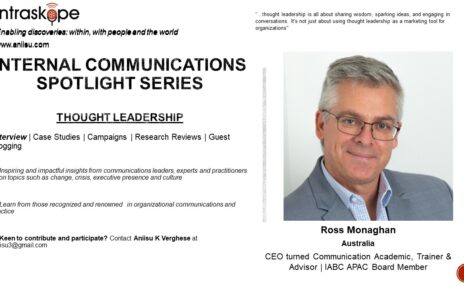What for?
- Especially, if Global Business Services (GBS) leaders are known for their knowledge and prowess within the firm?
- Especially, if stakeholders value what they do?
- Especially, if they are recognized for and are comfortable with their progress?
Why bother with thought leadership? What on earth is it anyway and why must you care if you are a GBS leader?
Consider these data points:
- 75% of potential buyers have made decisions on placing vendors on their list based on demonstrable thought leadership
- Over 50% of decision makers claim they spend more than absorbing thought leadership content than before the pandemic
- In a 2020 Accenture study, about 50% of workers agree that the ethical, sustainable and moral values that a company holds will become more important to them post pandemic
- After job security, organizational brand and reputation is now the #2 reason that people joined their current employer (a jump from #9 before the pandemic) – states a 2022 Mercer Global Talents study.
Thought leadership is about consideration and eminence through credibility. It isn’t only for selling products or services. Nor is it about ‘forwarding’ or liking someone else’s content. It extends to all forms of engagement and ‘selling’ to stakeholders – promoting the employee value proposition and roles, highlighting the culture, attracting and retaining talent, convincing internal clients, influencing community partners, enhancing reputation among industry bodies and governmental institutions and more. It is about building long term value for the brand and differentiating in the local market.
Thought leadership matters to all organizations and to all managers and leaders and everyone in the organization at any level. However, it matters even more to Global Business Services entities because these functions are often a step or two removed from business – either due to the distance created by locational constraints or due to the way the organization is structured. It is not ideal but that is unfortunately the reality when there are less customer-facing interactions in such scenarios. Please note that in this context, I use global business services as a term interchangeably for shared services or capability centers or hubs or in-house centers as many organizations have defined their entities.
There are misconceptions about thought leadership. That it must always be about –
- identifying innovative ideas and creative content.
- Or, that it can be done by senior leaders only.
- Or, that it must need heavy investment of funds and time.
- Or, it is only meant for the marketing team to own.
- Or, you need to only be a thought leader in your domain.
More than anything, these misconceptions come in the way of making progress or starting off with the basics needed for establishing thought leadership within the organization and to help it thrive. You don’t need to be an executive board member to be showcasing thought leadership. If you are passionate about what you do and how you want to make a difference to the world around you – you already have something meaningful to help your employer, your business and your community get distinguished.
According to me, there are three types of thought leadership – contemporary, convergent and divergent.
Contemporary thought leadership is building on the current and providing insights that differentiate the company, brand, offering, employee value proposition among others. For example, a HR leader can highlight the current state of the function and the value of ROI in people metrics – why not?
Convergent thought leadership aligns varied perspectives to surface new points of views. For example, a technology leader can address how cultural nuances are impacting IT adoption in the post-COVID world – why not?
Divergent thought leadership is an inside out approach inspiring debate and discussion on future ideas. For example, a business leader can address how bringing in concepts from other industries and areas such as behavioral sciences, biomimicry or space research can change fundamentally how businesses are run – why not?
All three approaches lead to strategic positioning and transformation for the brand and reputation, within and outside. This translates into presentations, lectures, blogs, articles, point of view pieces, whitepapers, research studies among others. By presenting thought leadership, GBS leaders can convince stakeholders that they have the chops for the job, are relevant in their field, have a mind of their own, can contribute to large initiatives beyond the role given – the benefits are numerous. In the process, it has a positive rub-off on the GBS leader or manager or staff.
- Why would prospective candidates consider joining a leader’s team when there aren’t demonstrable insights or newer ideas that the GBS leader has articulated?
- Why would internal customers consider the GBS leader to take over critical projects when they don’t hold stature within their own industry or domain?
- Why will industry forums provide slots for GBS leaders to present their work if there hasn’t been consistent thought leadership shared over the years?
If GBS leaders aren’t thinking or acting on thought leadership, there isn’t any point blaming prospective candidates for rejecting offers to join or point fingers at the hiring, brand and marketing teams for not doing enough or for internal stakeholders to prevent leaders from having a seat at the table. Does it require investment of time, effort and commitment? Does it need training and coaching?
There is no alternative but to put thought leadership front and center of the GBS leader’s agenda and goals.
Liked the article? Share your comments here.
Interested in similar content? Look up my blog www.aniisu.com and website www.intraskope.com
Keen to get advice on communication? Look it up here: https://www.intraskope.com/advantage
Interested to read other articles on Global Business Services/Shared Services/Global Capability Centers’ communication? Look them up on the Shared Services & Outsourcing Network website where I am a contributing author.
- Are GBS Organizations Differentiating Their Brands Locally?
- Roadmapping Global Capability Centers’ Communication Priorities and Progression
- Communications as a COE for Shared Services Success: Charting a New Direction
- Communications as a COE for Shared Services Success: Building The Strategy
- Communications as a Center of Excellence for Shared Services Success
- Crafting a Consistent Global Business Services Social Media Strategy
- 5 Communication Approaches for Successful Knowledge Transitions
- Designing a Consistent Business Problem-Solving Forum in Global Capability Centers
- Starting Your Global Shared Services Center? Give Communications its Due
- Building an Inclusive Shared Services Leader’s Communication Plan
- Tapping the Power of Ideas in Shared Services Centers
- Six P’s that Differentiate your Global Center
- 4 Shared Services Communication Strategies Guaranteed to Work
#GBS #GBScommunication #sharedservices #thoughtleadership #reputation # brand #transformation #eminence #decisionmaking #inhousecenters #capabilitycenters #HR #technology #business #strategy #communication #purpose #clarity #communicationtraining #GBSleadership #training #commsbarriers #commsperceptions #reputation #branding #localization #glocal #attrition #engagement #experience #convergent #contemporary



